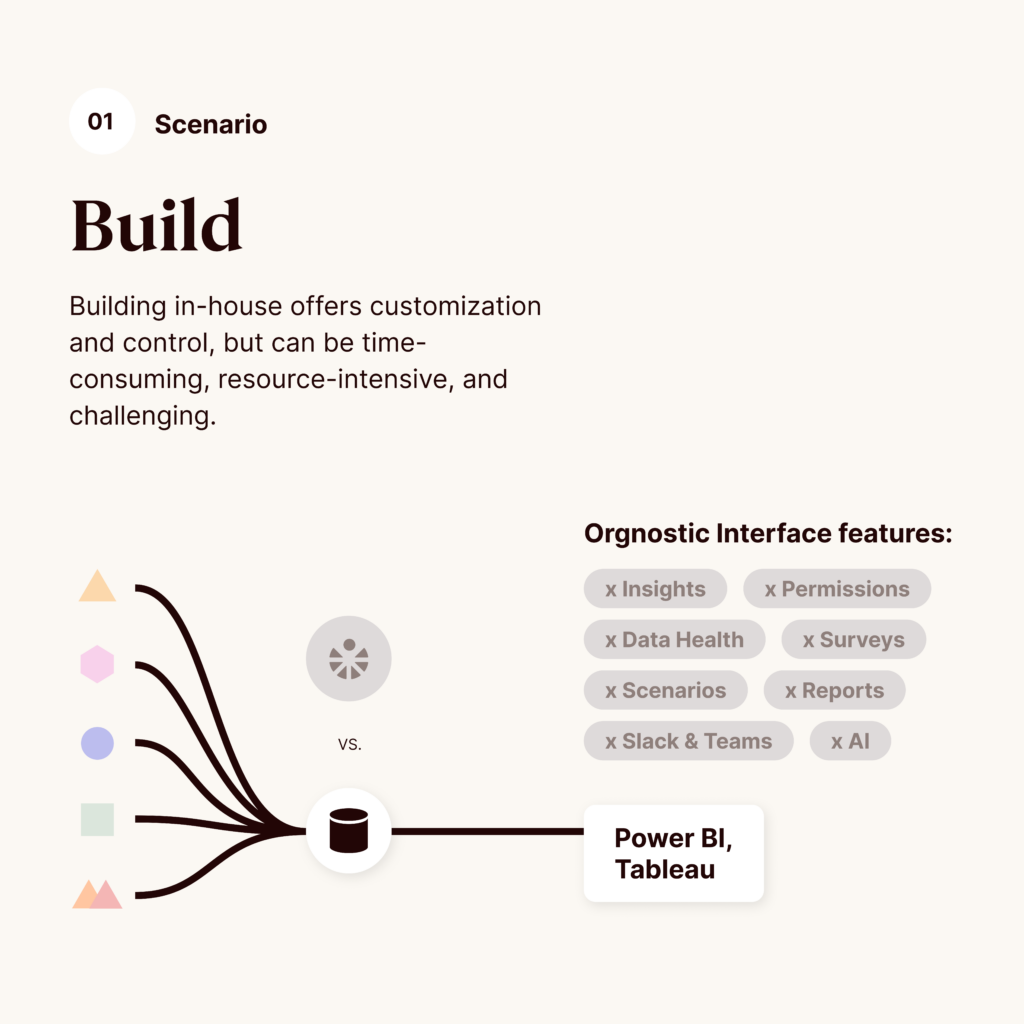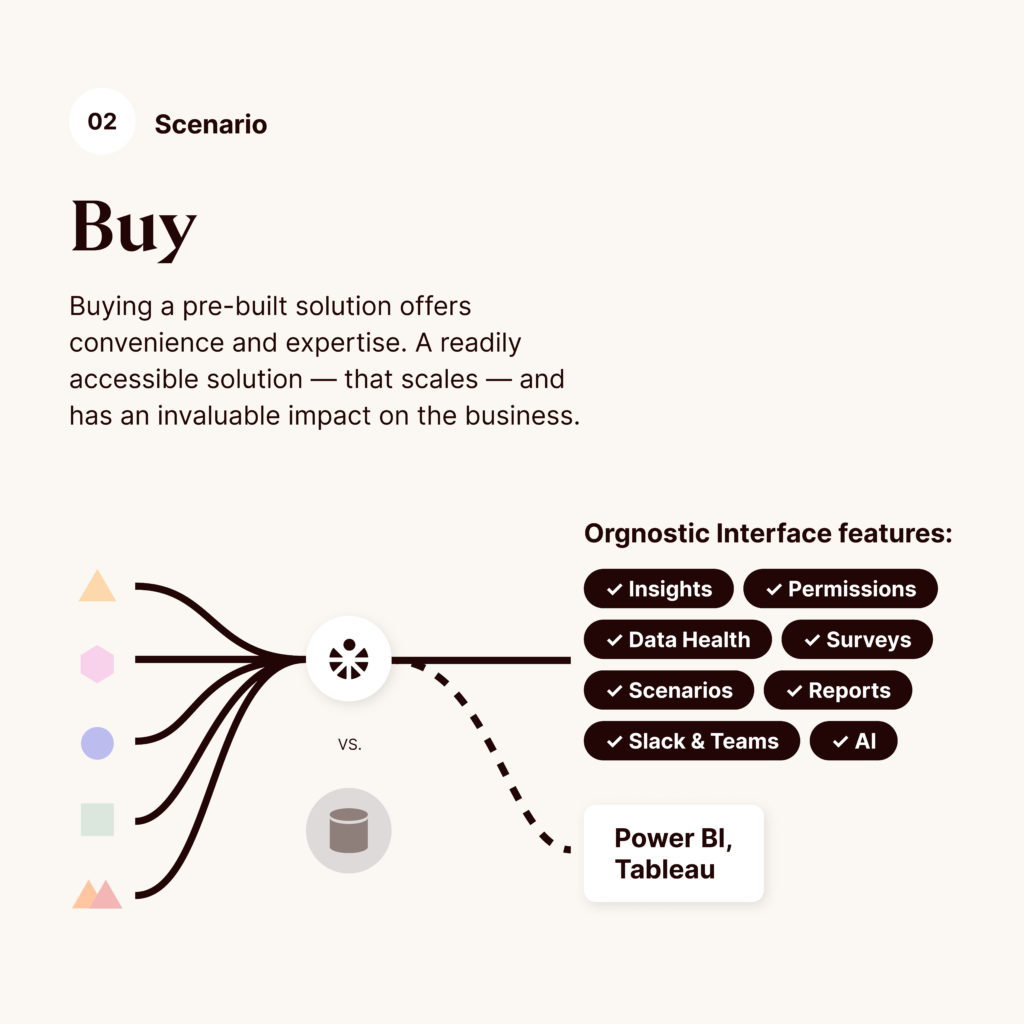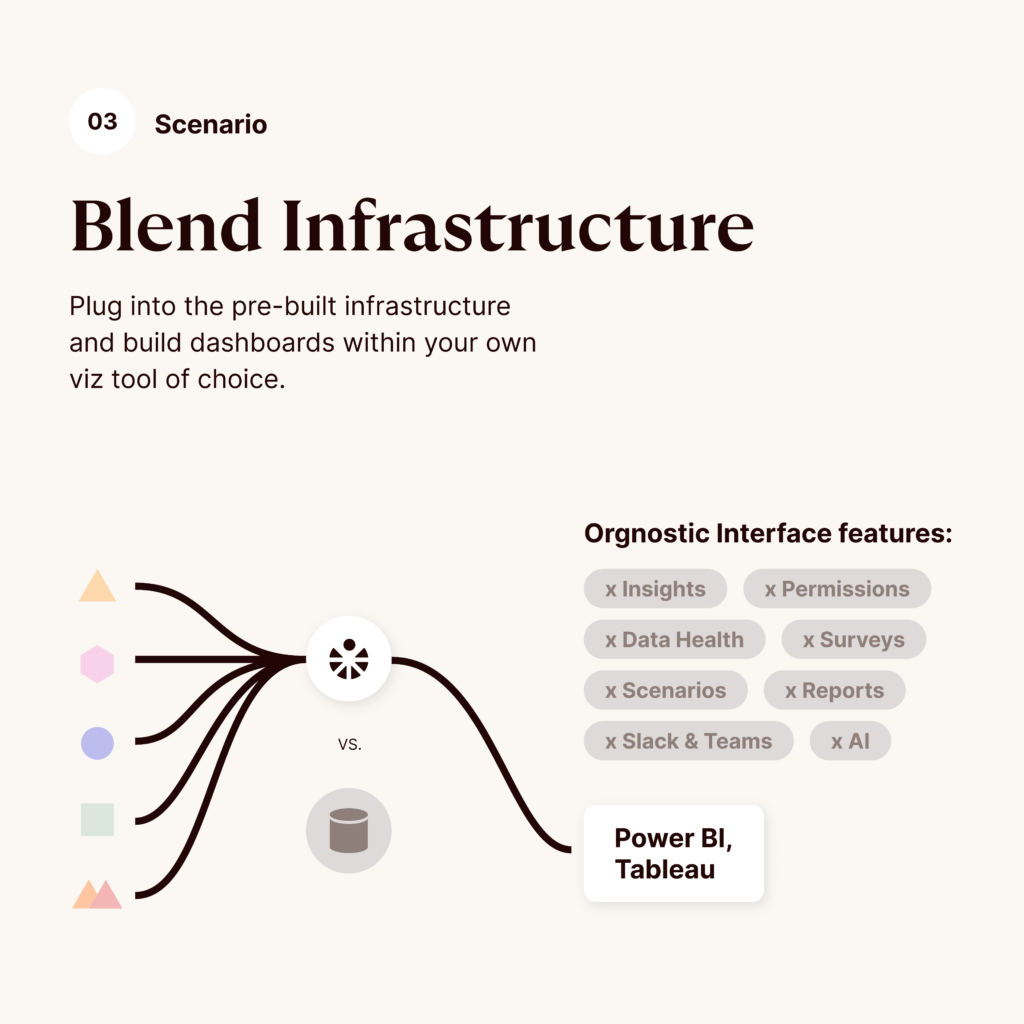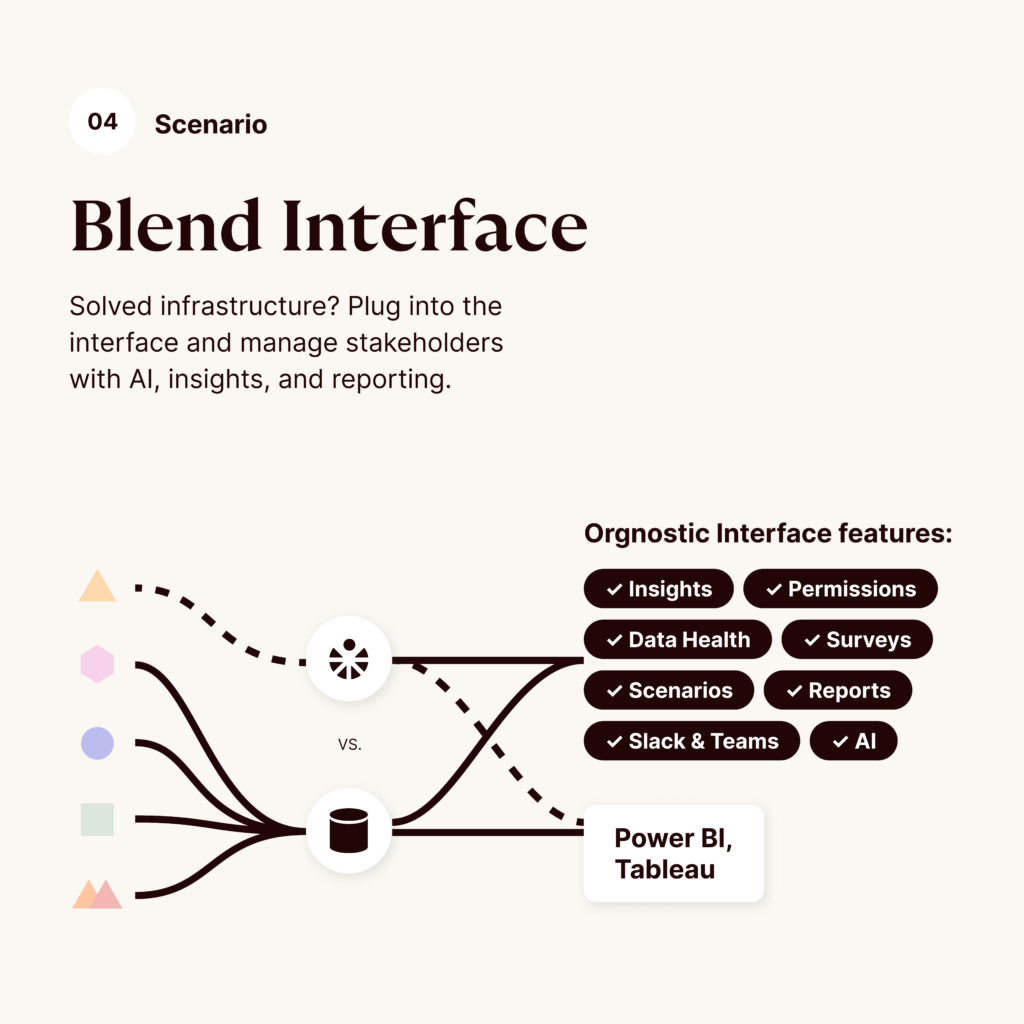Here’s what to ask yourself and your team when deciding whether to buy or build your people analytics tool — and how a blended approach might fit the best.
Organizations lean into people analytics for valuable insights on their workforce.
And then, their buying committees, including data analysts, HR, managers, all the way to legal, infosec, and procurement start leaning on technology.
The goal is to find the most effective means to an end — a path that lets everyone working with people data, from managers, to HRBPs, and all the way to C-suite get reliable, accurate, timely insights into the historical and current dynamics of the workforce. Bonus points if this means doesn’t overbear the user, but instead feeds them contextualized information so they can make the right decisions.
This brings us right away to the buy vs build dilemma: whether to procure a people analytics tool or build one from scratch?
Buy, build or blend?
If you were to give an answer offhand, both sides have their own merits — one gives you a chance to start getting and acting on workforce insights in a matter of days, the other promises more customization for your particular use case.
But to really make the most out of this fork in the road, the buy vs build dilemma isn’t an either/or matter.
With the current options today, this dilemma has become a matter of what’s the best combination for your particular maturity, size of the organization, data engineering capacities, budget, and urgency. One doesn’t exclude the other.
And there is another option to consider — a blended approach, where you get the most of both options and strike the right balance between scalability and customization, all without having to wait on the lengthy project of internally building a solution to come to fruition.




As we cover each of these options, we will look at the benefits of each approach and the traps to avoid — all through the lens of the criteria you should factor in when making the final decision.
To build or buy a PA tool: benefits and challenges
Getting a ready-made people analytics tool gives you speed, takes fewer resources and acts as your force multiplier. Check out this quick summary on what you get when you get a people analytics tool and what traps to watch out for if you decide to build your tool from scratch:
Criteria to decide whether to build or buy your people analytics tool
To make an informed decision on getting a turnkey people analytics solution, building one yourself, or plugging into some of the vendor capabilities, there are a number of factors to consider. We’ve grouped them into the following:
- Time-to-value
- Costs
- Ability to customize
- Data security and compliance
- Integration options
- Maintenance
- Scalability
- User adoption
Once you evaluate these criteria, you can make an informed decision that aligns with your organization’s unique needs and objectives. In the next section, we look at each of these factors and assess each of the three approaches.
Time-To-Value
| Buy | Build | Blend |
|---|---|---|
| Buying a ready-made tool means quicker implementation and a faster time-to-value. You get a fully functional tool in a matter of days. | Building an internal tool often takes a longer time, delaying the benefits of having advanced analytics capabilities. | Plugging into a ready-made tool speeds up the process significantly, but how fast you derive value depends on how fast you can implement the in-house build. |
Costs
| Buy | Build | Blend |
|---|---|---|
| Buying a pre-existing tool may seem expensive upfront, but you will bear no unforeseen costs down the line. | Seemingly cheaper at the start, but costs more down the line, as you need to invest in development, maintenance, and ongoing support. | The blended approach is still cheaper than building an entire tool from scratch. Still, you can’t foresee all costs linked to building internally. |
Customization
| Buy | Build | Blend |
|---|---|---|
| Ready-made tools offer standard features and functionalities. While Orgnostic’s platform is readily available, it offers a great dose of flexibility. Check the customization field under ‘Blend’ for more. | Building internally allows for customization to specific company needs. However, first assess the feasibility of your desired customization as it may require a lot more time, expertise, and resources. | A blended approach is a good option for customizable use cases. For example, Orgnostic lets you plug into the platform back end data engineering work, and then build the dashboards within your existing BI tools or programming environment. Alternatively, if you have data infrastructure solved, you can get Orgnostic to plug in and use it for stakeholder engagement functionalities such as AI, guided insights, or automated reporting. |
Data security and compliance
| Buy | Build | Blend |
|---|---|---|
| Buying a tool from a reputable vendor provides security in terms of compliance, especially when it comes to meeting GDPR’s stringent rules on storing and sharing data. Vendors with SOC2 Type 2 controls in place have strict policy standards on data security and are actively monitored. Permissions setup tend to allow more flexibility with internal data sharing. | To keep compliance and good HR practice, HR would need to limit the involvement of the company data engineering, data science, and analytics functions to reduce the risk of PII and confidential data exposure to the unauthorized staff. Most of the data visualization tools lack the depth of permissioning needed to handle people data. | A blended approach still requires diligent assessment of how data is handled and processed. While entrusting part of the work to a vendor keeps your team safe from violating data security standards, you still need to check if your existing tools support the permissioning needed to meet security and privacy standards. |
Integration
| Buy | Build | Blend |
|---|---|---|
| A tool with a canonical data model comes with pre-built API integrations with different HR systems, which means you can connect all your data in as little as a couple of days. Orgnostic for instance integrates with all the leading HRIS and ATS systems. | This is one of the biggest challenges with internal build as it requires extensive work to ensure seamless integration with existing systems and significant data engineering resources for ETL development. | Orgnostic already integrates with leading HR tools. This means you can build on top of a robust structure and get the insights in the environment your team is accustomed to, without having to allocate significant resources to ETL development. |
Domain expertise
| Buy | Build | Blend |
|---|---|---|
| Leveraging an external vendor lets you make the best use of a whole team of experts, who have worked together before and know how to tackle the issues that might arise. | Building an internal tool demands a team with specialized skills in data analytics, software development and HR and people analytics domain expertise. | This path lets you make use of the vendor teams’ expertise — when you need it. Working together, your team will always have a reliable partner with whom they can overcome obstacles as your needs for people analytics grow. |
Maintenance
| Buy | Build | Blend |
|---|---|---|
| When you purchase a PA tool from a vendor, you get access to their support and maintenance services. For instance, this means that Orgnostic takes care of addressing any technical issues, releasing updates, and ensuring the tool’s smooth operation. | With the internal build, you need to allocate resources for continuous maintenance, updates, and improvements, and deal with continuous updates and technical issues. | The more people analytics work you entrust to a reputable vendor, the lower the costs of maintenance will be. When you entrust data engineering work to Orgnostic, you fully offload maintenance, improvements, and updates, with no unpredicted costs. |
Scalability
| Buy | Build | Blend |
|---|---|---|
| Your organization, along with your PA function will grow. A tool you purchase will easily accommodate increased data and user demands, so there is no need for expanding the tech infrastructure on your own. | If you decide to pursue this path, make sure to factor in whether your internal tool can scale effectively to support the future needs. This often requires additional work that is difficult to assess cost-wise over the long run. | With the blended approach, you can scale more affordably. This option gives you a chance to rely on a vendor tool to support increasing data needs, while you can still internally tweak parts of the work that require customization. |
User adoption
| Buy | Build | Blend |
|---|---|---|
| Vendor tools are built and created with the user at the center, making it easier for various roles on your team to find the tool easy to use. In the case of Orgnostic, it’s not only about the UX fit for HRs and managers, but supporting materials, including tailored online courses, community, and round-the-clock support. | An internally built tool requires more effort in terms of user training and change management. You not only need to build the tool from scratch, but also make sure your team is well-versed and supported in initial stages, which adds to the overall costs. | A blended approach can reduce disruptions in your team’s work. With Orgnostic, your team still gets to work in their BI tool of choice, or programming environment — and still has the added benefits of online courses, community and support. |
Learn how Orgnostic can help strike the right balance between speed and customization.
Book a free personalized ideation session and see how you can cut time to impact →